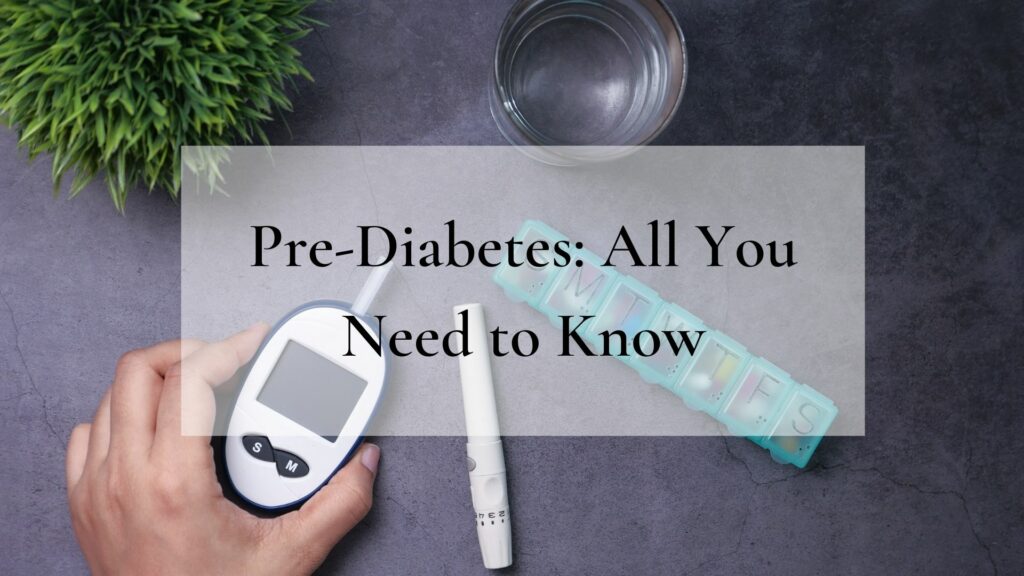Pre-diabetes is a disease that puzzles many people. It’s hard for pre-diabetics to get the treatment they need because it can be difficult to diagnose pre-diabetes. The pre-diabetes test, which screens blood sugar levels, is not always accurate and may provide false results. This article will explore pre-diabetes in-depth and give readers some insight into how it works.
Contents
What is Pre-Diabetes?
Pre-diabetes is a sickness where blood glucose levels are higher than normal, however not sufficiently high yet to call it to type II diabetes.
If you don’t treat it and get your blood glucose under control, the disease can progress until you develop type II diabetes or gestational diabetes (diabetes during pregnancy).
If you treat pre-diabetes it might help you not get type 2 diabetes, heart disease, kidney problems, and more.
Symptoms of Pre-Diabetes
There are no symptoms for pre-diabetes itself. If you have it, you may feel tired. It may take a while for someone to realize they have it because there are no signs.
Some of the symptoms for pre-diabetics are:
– the person may start losing weight suddenly.
-person may have increased thirst which further leads to frequent urination
- may have a blurry vision
- Darkened skin on certain areas of the body is another symptom of pre-diabetes. The neck, armpits, elbows, knees, and fingertips are among the afflicted regions.
When to See a Doctor?

If you have had pre-diabetes for many years, it will be hard to reverse it. You should change some things that will help your body get healthy again. If you have any diabetes risk factors, ask your doctor whether you should get blood sugar testing.
Causes and Risk Factors
If you have any of the following symptoms, you’re more likely to get prediabetes:
- Are you over the age of 45
- If you’re a guy, your waist must measure more than 40 inches around. If you’re a lady, it should be 35 inches.
- Eat red and processed meat frequently, drink sugary beverages often, and don’t eat much fruit or vegetables.
- High cholesterol, high triglycerides, low HDL cholesterol, and
- Do not indulge in physical activities
- If you have gestational diabetes or gave birth to a child who weighed more than 9 pounds
- have PCOS
- do not have a fixed sleep schedule or suffer from sleep apnea
If you match any of these conditions mentioned above, the doctor may test you if: The level of your blood sugar is not normal.
- You have a disease that affects the heart.
- You show signs that your body does not react well to insulin, which includes skin discoloration in certain areas, may face trouble in focus and concentration and show more fatigue or hunger than usual.
Diagnosis and Testing of Pre-Diabetes
The doctor may conduct one of the following tests –
- Fasting plasma glucose test. You’ll go without food for 8 hours, after which a laboratory technician will draw your blood to look at sugar levels. The following are the outcomes: If your blood sugar is less than 100 mg/dL, it’s considered normal. It’s pre-diabetes if it’s between 100 and 125 mg/dL. If the blood sugar level is more than 125 you are most likely to have diabetes.
An oral glucose tolerance test (OGTT) measures your glucose tolerance by testing how quickly your body absorbs and metabolizes carbohydrates. For the first step, you’ll undergo a fasting plasma blood test. Then you’ll drink something sweetened, after which a technician will take and examine more blood two hours later. The results are:
- Diabetes develops when your blood sugar level is higher than normal.
- After the second test, diabetes can develop if your blood sugar is 140 mg/dL or lower.
- If it’s above 140, but less than 200 mg/dL, you have pre-diabetes.
A1c is a test for diabetes that measures the average sugar level in your blood over two to three months. It’s given to people with diabetes to check if their blood sugar levels are under control. It may also be used to diagnose prediabetes or diabetes. The results are:
- Normal if it’s 5.6% or less
- Pre-diabetes if it’s 5.7 to 6.4%
- Diabetes if it’s 6.5% or above
Testing Children with Pre-Diabetes

The medical community is just starting to understand pre-diabetes and what it means for adults. Now more focus is given to children, teenagers, and young adults suffering from pre-diabetes.
Up until recently, pre-diabetes was not often considered a disease of childhood because doctors thought that if people developed Type Two Diabetes as an adult they must have had pre-diabetes as a child.
No matter who the patient is, his or her blood sugar levels are treated in the same way. The American Diabetes Association advises that children ten and older who are overweight or obese and have any of the above symptoms should be tested :
- A parent with diabetes if the child is a diabetic.
- A mother who had gestational diabetes while carrying the baby
- Signs of insulin resistance or diseases related to it, such as low birth weight, high blood pressure, or polycystic ovary syndrome.
- A child who is at risk of diabetes should be tested every three years. If their test results are normal, they should ask their doctor to retest them again in three years.
Complications
The most serious consequence of prediabetes is the development of type 2 diabetes. As the disease has progressed to the next stage, i.e. diabetes, the person may suffer from –
- High blood pressure
- High cholesterol
- Heart disease
- Stroke
- Kidney disease
- Nerve damage
- Vision problems, possibly loss of vision
- Amputations
Even if one doesn’t have pre-diabetes, it is said to be the reason for silent heart attacks and severe damage to the kidneys of individuals.
Prevention and Treatment
If you have pre-diabetes there is still hope for you to keep pre-diabetes under control.
Prevention of pre-diabetes should be a person’s main goal. Eating healthy and staying active can help prevent the condition from happening, as well as use it early on if it happens.
In addition to this, there are certain medications that have been shown to help manage blood sugar levels effectively.
Some other prevention methods are –
- Stop smoking immediately.
- Control your blood pressure and cholesterol levels.
- If you’re at risk of diabetes, take metformin (Glucophage) to lower your blood sugar levels.
Diet for Pre-Diabetes

There is no special diet for diabetics, but there are four things that may help. Here they are:
- Eat less sugar
- Eat more protein and vegetables
- Drink water instead of soda or juice all the time.
- Walk more
- One should include more whole grain products and avoid carbohydrates such as white bread, potatoes, and other breakfast cereals.
- Instead of sweet beverages, have coffee, water, or tea.
- Choose healthy fats such as those found in vegetable oil, nuts, and seeds instead of margarine, baked goods, and fried foods.
- It is better for you to eat other types of food like nuts or whole grains. It is also good to eat chicken, fish, and beans.
Conclusion
The prevalence of pre-diabetes is on the rise. There are many things people can do at home or in their workplace to help prevent pre-diabetes from turning into a more serious diagnosis including eating healthier meals and exercising regularly. Have you taken any preventive measures against developing this condition? What has worked well for you so far?
Do you want to get rid of diabetes? Join our online diabetes consultation program and reverse your Diabetes naturally through lifestyle changes such as a Personalized Diet plan, Exercise, dieticians, and health coaches.


